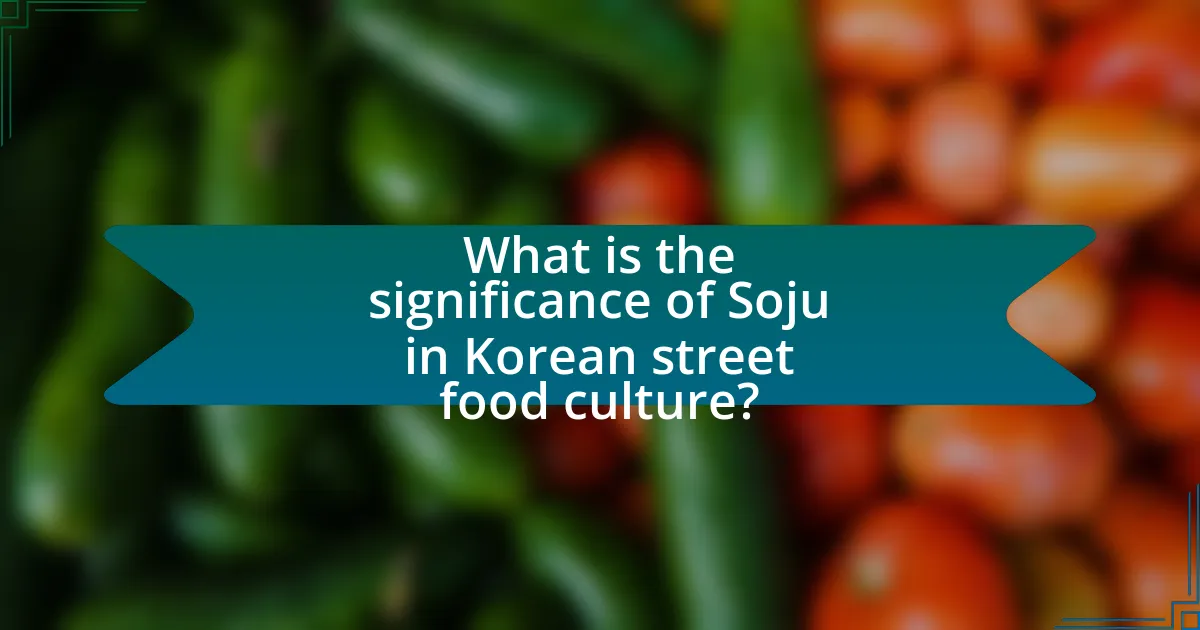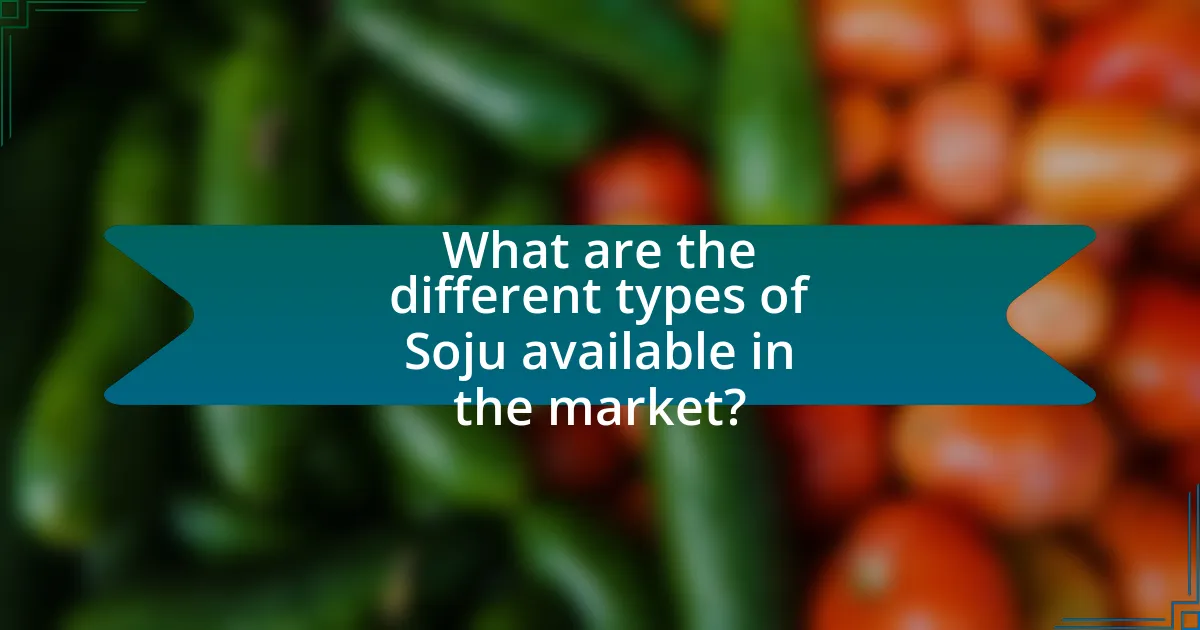Soju is a distilled spirit that plays a crucial role in Korean street food culture, commonly enjoyed alongside popular dishes such as tteokbokki and fried snacks. Its affordability and social significance foster camaraderie among diners, enhancing the overall experience of communal eating. The article explores the traditional consumption practices of Soju, its historical roots, and the various types available in the market, including flavored and premium options. Additionally, it examines how Soju facilitates social interactions, reflects Korean customs, and the evolving perception of this beverage in modern society, particularly among younger generations. Health considerations related to Soju consumption, as well as tips for enhancing the Soju and street food experience, are also discussed.

What is the significance of Soju in Korean street food culture?
Soju holds significant cultural importance in Korean street food culture as it is commonly consumed alongside various street food dishes, enhancing the overall dining experience. This distilled spirit, typically made from rice, barley, or sweet potatoes, complements the flavors of popular street foods such as tteokbokki (spicy rice cakes) and fried snacks. The social aspect of sharing soju fosters camaraderie among friends and family, making it a staple in communal eating settings. Furthermore, soju’s affordability and accessibility contribute to its prevalence in street food environments, where it is often enjoyed in casual, lively atmospheres.
How is Soju traditionally consumed with street food?
Soju is traditionally consumed with street food by pairing it with various popular dishes, enhancing the overall dining experience. In South Korea, it is common to enjoy soju alongside street foods like tteokbokki (spicy rice cakes), hotteok (sweet pancakes), and fried snacks, as the alcohol complements the flavors and spices of these foods. This practice is rooted in social customs, where sharing soju fosters camaraderie among friends and family while enjoying casual meals in vibrant street food markets.
What types of street food pair well with Soju?
Fried chicken pairs well with Soju, as the crispy texture and savory flavor complement the drink’s smoothness. Additionally, spicy tteokbokki, which consists of chewy rice cakes in a hot sauce, enhances the Soju experience by balancing its sweetness with heat. Grilled meats, such as skewered pork or beef, also match well due to their rich flavors that harmonize with Soju’s clean finish. These pairings are popular in Korean street food culture, where Soju is often enjoyed alongside these dishes to elevate the dining experience.
How does the consumption of Soju enhance the street food experience?
The consumption of Soju enhances the street food experience by complementing the flavors of various dishes and fostering social interactions. Soju, a traditional Korean distilled spirit, has a clean and neutral taste that pairs well with spicy and savory street foods, such as tteokbokki and fried chicken. This pairing not only elevates the overall taste but also encourages diners to enjoy their meals in a communal setting, as sharing drinks is a common practice in Korean culture. Furthermore, studies indicate that the act of consuming alcohol, like Soju, can enhance the enjoyment of food through sensory stimulation, making the street food experience more memorable and enjoyable.
Why is Soju considered a cultural staple in Korea?
Soju is considered a cultural staple in Korea due to its deep-rooted presence in social gatherings and traditional customs. This distilled beverage, typically made from rice, barley, or sweet potatoes, is often consumed during meals and celebrations, reinforcing its role in fostering community and connection among individuals. Historically, soju has been a part of Korean culture since the 13th century, with its popularity surging in the 20th century, making it the most consumed alcoholic beverage in Korea. In 2020, soju accounted for approximately 60% of the total alcohol market in South Korea, highlighting its significance in daily life and social interactions.
What historical factors contributed to Soju’s popularity?
Soju’s popularity is primarily attributed to its historical roots in Korea, dating back to the 13th century when it was introduced by Mongolian invaders. The introduction of distillation techniques allowed for the production of this clear spirit, which became widely consumed due to its affordability and versatility. Over the centuries, soju evolved from a luxury item to a staple beverage among all social classes, particularly during the Joseon Dynasty when it was often consumed with meals. The post-war economic boom in the 20th century further solidified its status as a popular drink, as it became associated with social gatherings and celebrations. Additionally, the rise of Korean pop culture and globalization in recent decades has contributed to its international appeal, making soju a symbol of Korean identity.
How does Soju reflect Korean social customs and traditions?
Soju reflects Korean social customs and traditions by serving as a central element in communal gatherings and celebrations. In Korea, drinking soju is often accompanied by specific rituals, such as pouring drinks for others as a sign of respect and camaraderie, which emphasizes the importance of social hierarchy and relationships. Additionally, soju is commonly consumed during traditional events like weddings and holidays, reinforcing its role in cultural practices. The beverage’s historical significance dates back to the 13th century, when it was introduced to Korea, and it has since become a staple in both casual and formal settings, illustrating its deep-rooted connection to Korean identity and social interaction.

What are the different types of Soju available in the market?
The different types of Soju available in the market include traditional Soju, flavored Soju, and premium Soju. Traditional Soju is typically distilled from grains or sweet potatoes and has an alcohol content ranging from 16% to 25%. Flavored Soju, which has gained popularity, comes in various fruit flavors such as peach, grapefruit, and green apple, appealing to a broader audience. Premium Soju is often made with higher quality ingredients and undergoes a more refined distillation process, resulting in a smoother taste and higher price point. These variations cater to diverse consumer preferences and enhance the experience of enjoying Soju alongside Korean street food.
How do the various types of Soju differ in flavor and alcohol content?
Various types of Soju differ in flavor and alcohol content primarily due to their ingredients and production methods. Traditional Soju, often made from rice, barley, or sweet potatoes, typically has an alcohol content ranging from 16% to 25%, with a clean, neutral flavor profile. In contrast, flavored Soju varieties, which incorporate fruits like peach or grapefruit, maintain a similar alcohol content but offer distinct, sweeter flavors that appeal to a broader audience. Additionally, premium Soju brands may have higher alcohol content, sometimes exceeding 25%, and are crafted to provide a smoother taste experience, often described as more refined compared to standard options. This variation in flavor and alcohol content reflects the diverse preferences within Korean street food culture, where Soju is commonly paired with various dishes.
What are the characteristics of traditional Soju?
Traditional Soju is a clear, distilled alcoholic beverage from Korea, typically made from grains like rice, barley, or wheat. It has an alcohol content ranging from 16% to 25%, making it stronger than beer but milder than many spirits. The flavor profile of traditional Soju is often described as neutral or slightly sweet, with a smooth finish, which allows it to pair well with various foods, particularly in the context of Korean street food culture. Historically, Soju has been produced since the 13th century, and its production methods have evolved, with traditional Soju often being made through a single distillation process, which contributes to its unique characteristics.
How do flavored Soju varieties impact street food pairings?
Flavored Soju varieties enhance street food pairings by complementing and contrasting the flavors of various dishes. For instance, fruity flavored Soju, such as peach or grape, pairs well with spicy street foods like tteokbokki, as the sweetness balances the heat. Additionally, herbal or citrus-flavored Soju can elevate the taste of savory items like fried chicken or kimbap, creating a harmonious dining experience. This pairing dynamic is supported by consumer preferences, as surveys indicate that flavored Soju is increasingly popular among younger demographics, who seek innovative combinations with street food.
What role does Soju play in social gatherings around street food?
Soju serves as a central alcoholic beverage in social gatherings around street food in Korea, enhancing the communal dining experience. It is often consumed alongside various street food items, such as tteokbokki and hotteok, fostering a sense of camaraderie among friends and family. The tradition of sharing soju during these gatherings is rooted in Korean culture, where drinking together is seen as a way to strengthen social bonds. Additionally, the versatility of soju, with its range of flavors and relatively low cost, makes it an accessible choice for many, further solidifying its role in these social settings.
How does Soju facilitate social interactions among street food patrons?
Soju facilitates social interactions among street food patrons by serving as a common beverage that encourages sharing and communal drinking experiences. In Korean culture, drinking soju is often accompanied by food, particularly street food, which enhances the social atmosphere and fosters connections among individuals. The act of toasting and sharing soju creates a sense of camaraderie, making it easier for patrons to engage in conversations and build relationships. Additionally, the affordability and accessibility of soju at street food stalls contribute to its role as a social lubricant, allowing diverse groups of people to gather and enjoy each other’s company in a relaxed setting.
What are common rituals or practices involving Soju at street food stalls?
Common rituals involving Soju at street food stalls include sharing drinks among friends, toasting before drinking, and pairing Soju with specific street foods like tteokbokki and fried chicken. These practices foster social bonding and enhance the dining experience. In South Korea, it is customary to pour Soju for others rather than oneself, symbolizing respect and camaraderie. Additionally, the act of clinking glasses while making eye contact during a toast is a widely observed ritual, reinforcing social connections. These traditions are integral to the communal atmosphere prevalent in Korean street food culture.

How has the perception of Soju evolved in modern Korean society?
The perception of Soju in modern Korean society has shifted from being viewed primarily as a low-cost, traditional alcoholic beverage to a more sophisticated and versatile drink enjoyed in various social contexts. This evolution is evidenced by the rise of premium Soju brands and innovative cocktails that incorporate Soju, appealing to younger generations and urban consumers. Additionally, Soju’s integration into contemporary dining experiences, including pairing with gourmet street food, reflects its growing status as a cultural symbol rather than just a cheap drink.
What trends are influencing the consumption of Soju today?
Current trends influencing the consumption of Soju include the rise of flavored varieties, increased popularity among younger consumers, and the integration of Soju into diverse culinary experiences. Flavored Soju, such as peach and grapefruit, has gained traction, appealing to a broader audience and enhancing its presence in social settings. Additionally, younger consumers, particularly millennials and Gen Z, are driving demand through social media platforms, where Soju cocktails and innovative pairings with street food are showcased. This demographic shift is supported by a 2021 report from the Korea Alcohol and Liquor Industry Association, which noted a 15% increase in Soju consumption among individuals aged 20-30. Furthermore, the pairing of Soju with Korean street food, such as tteokbokki and fried chicken, has become a cultural phenomenon, reinforcing its role in social dining experiences.
How are younger generations redefining Soju’s role in street food culture?
Younger generations are redefining Soju’s role in street food culture by integrating it into a more casual and social dining experience. This shift is evident as younger consumers increasingly pair Soju with diverse street food options, moving beyond traditional pairings like grilled meat. For instance, a survey by the Korea Food Industry Association in 2022 indicated that 65% of young adults now enjoy Soju with a variety of street foods, such as tteokbokki and hotteok, reflecting a broader acceptance of Soju in informal settings. This trend highlights a cultural evolution where Soju is seen as a versatile beverage that enhances the enjoyment of various street food, thus reshaping its traditional image.
What impact does globalization have on Soju’s popularity?
Globalization has significantly increased Soju’s popularity by expanding its availability and cultural reach beyond South Korea. As international interest in Korean cuisine and culture has surged, particularly through the Korean Wave (Hallyu), Soju has become a staple in global markets, with exports rising from 1.5 million liters in 2000 to over 10 million liters in 2020. This growth is supported by the rise of Korean restaurants and bars worldwide, which feature Soju as a key beverage, thus enhancing its visibility and consumption among diverse populations.
What are the health considerations associated with Soju consumption?
Soju consumption is associated with several health considerations, including the risk of alcohol-related diseases, potential for addiction, and effects on mental health. Regular intake of soju, which has a high alcohol content (typically around 20% ABV), can lead to liver damage, cardiovascular issues, and an increased risk of certain cancers, as supported by studies indicating that heavy alcohol consumption is linked to liver cirrhosis and various malignancies. Additionally, the potential for addiction is significant, with research showing that alcohol dependence can develop with frequent use, impacting social and personal well-being. Furthermore, excessive soju consumption can exacerbate mental health issues, such as depression and anxiety, as alcohol is known to affect neurotransmitter balance in the brain.
How does moderate Soju consumption affect health?
Moderate Soju consumption can have both positive and negative effects on health. Research indicates that moderate alcohol intake, including Soju, may be associated with certain cardiovascular benefits, such as improved heart health and reduced risk of heart disease, due to its potential to increase high-density lipoprotein (HDL) cholesterol levels. However, excessive consumption can lead to negative health outcomes, including liver disease, addiction, and increased risk of certain cancers. A study published in the Journal of Clinical Medicine by Kim et al. (2020) found that moderate alcohol consumption is linked to lower mortality rates compared to heavy drinking or complete abstinence. Therefore, while moderate Soju consumption may offer some health benefits, it is essential to balance it with awareness of the risks associated with higher intake levels.
What are the risks of excessive Soju consumption in street food settings?
Excessive Soju consumption in street food settings poses significant health risks, including alcohol poisoning, impaired judgment, and increased likelihood of accidents. Alcohol poisoning can occur due to high alcohol content, with Soju typically containing around 16-25% alcohol by volume, leading to severe health complications. Impaired judgment from intoxication can result in risky behaviors, such as unsafe interactions with street vendors or other patrons. Additionally, the combination of Soju with spicy street food can exacerbate gastrointestinal issues, increasing the risk of nausea and vomiting. These risks highlight the need for moderation in consumption to ensure safety and well-being in social dining environments.
What tips can enhance the Soju and street food experience?
To enhance the Soju and street food experience, pairing Soju with complementary street food items is essential. For instance, Soju pairs well with spicy dishes like tteokbokki or savory options like kimbap, as the alcohol helps to balance the flavors and enhance the overall taste. Additionally, serving Soju chilled can elevate the drinking experience, making it more refreshing, especially in warm weather. Sharing Soju among friends while enjoying street food fosters a communal atmosphere, which is a significant aspect of Korean dining culture. This social aspect is supported by the tradition of pouring drinks for one another, which strengthens bonds and enhances enjoyment.


